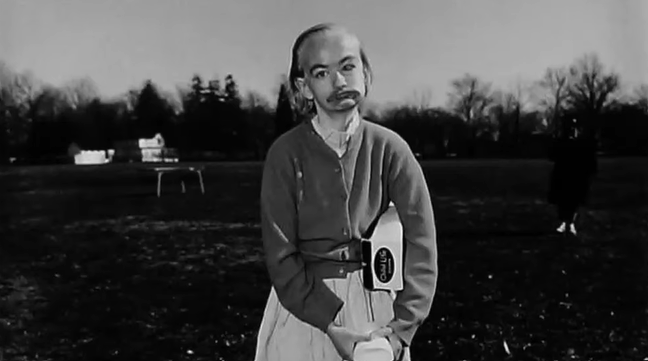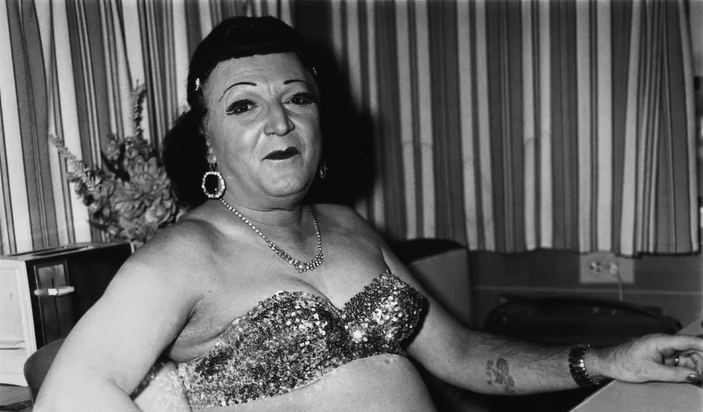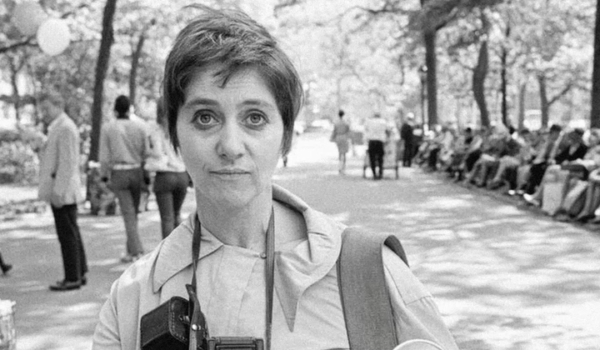Born Diane Nemerov on March 14, 1923, in New York City, Diane Arbus was the daughter of Gertrude Russek and David Nemerov, owners of Russek’s, a popular department store in the city. Surrounded by affluence, she was exposed to the arts at a young age. Her artistic journey began with painting before she transitioned to photography, and it was in photography that she found her true calling.
Arbus’s initial foray into photography was through a commercial partnership with her husband, Allan Arbus, named ‘Diane & Allan Arbus’. Their work primarily focused on fashion and were often featured in prestigious magazines like Vogue. However, Arbus felt that this did not align with her artistic vision, leading her to pursue an independent career in the late 1950s.

Arbus’s Preferred Subjects
A significant aspect of Diane Arbus’s work was her choice of subjects. She was particularly drawn to people who lived on the fringes of society, often ignored or marginalised by mainstream culture.
Her subjects included:
- People with physical abnormalities or disabilities: Arbus found beauty and uniqueness in individuals that society might label as abnormal. Her portraits of these people were not exploitative but intended to highlight their inherent dignity and humanity;
- Members of the LGBTQ+ community: Arbus was one of the first photographers to portray the LGBTQ+ community with honesty and respect. Her portraits often captured them in their everyday environments, reflecting their lives as authentically as possible;
- Circus performers and dwarfs: Arbus often spent time in circus camps, building relationships with the performers there. Her portraits of dwarfs and circus performers are intimate, showing them outside of their performing roles and humanising them in a way few photographers had done before;
- Elderly people: Arbus’s portraits of the elderly are filled with empathy and compassion. She often photographed them in their homes or retirement facilities, offering a poignant view into their lives;
- Twins and triplets: Arbus had a fascination with identical siblings, resulting in some of her most striking work. She often captured the similarities and subtle differences between them, creating an eerie and captivating effect.
Notable Works of Diane Arbus
Diane Arbus’s portfolio contains numerous influential works, each carrying her distinctive touch. Below are descriptions of three of her most famous photographs.
Three Notable Works of Diane Arbus
| Title | Description |
|---|---|
| Identical Twins, Roselle, New Jersey (1967) | A black-and-white photograph showing identical twin sisters dressed in identical outfits, staring directly at the camera. The twins’ subtly different expressions give the image a haunting quality. |
| Jewish Giant at Home with His Parents in the Bronx, New York (1970) | The photograph features Eddie Carmel, also known as ‘The Jewish Giant’, standing with his much shorter parents in their apartment. The image portrays the everyday challenges of living with gigantism, demonstrating the unique dynamics of this family. |
| A Young Man in Curlers at Home on West 20th Street, NYC (1966) | This image depicts a young drag queen sitting in his apartment, wearing curlers and applying makeup. The photograph is a candid, intimate portrayal of gender non-conformity in an era when such identities were not widely accepted or understood. |
Arbus’s Approach to Photography: An Ethnographic Study
Diane Arbus, the renowned American photographer, had a unique and groundbreaking approach to her work. Rather than simply capturing images of her subjects, she embraced an ethnographic study, immersing herself in their lives to create intimate portraits that revealed the essence of her subjects and their surroundings. This approach revolutionized the art of photography, making her a celebrated figure in the world of visual storytelling.
Research
At the core of Arbus’s approach was thorough research. Before even lifting her camera, she dedicated considerable time to understanding her subjects on a deeper level. This initial stage was crucial in enabling her to connect with her subjects in a meaningful way. Her research process involved:
- Lifestyle Analysis: Arbus studied the lifestyle of her subjects to comprehend their day-to-day activities, habits, and rituals. This insight allowed her to capture photographs that were authentic and reflected the essence of her subjects’ lives;
- Understanding Challenges: Arbus empathized with the challenges faced by her subjects, whether they were marginalized communities, individuals with unique conditions, or people living on the fringes of society. This understanding helped her approach her subjects with sensitivity and respect;
- Hopes and Dreams: Delving into the aspirations and dreams of her subjects, Arbus sought to portray their inner worlds and emotional landscapes. This added a layer of depth to her photographs, making them powerful portrayals of the human experience.
Interaction
Building a genuine relationship with her subjects was paramount to Arbus. She didn’t approach her work as an outsider looking in, but rather as someone keen on engaging and understanding the lives of those she photographed. The interaction stage included:
- Establishing Trust: Arbus worked diligently to earn the trust of her subjects. By being open, empathetic, and non-judgmental, she created an environment where her subjects felt comfortable expressing themselves freely;
- Cultural Exchange: Embracing the principles of ethnography, Arbus sought to create a cultural exchange between herself and her subjects. She shared her own experiences, beliefs, and emotions, which, in turn, encouraged her subjects to open up and share their stories;
- Breaking Barriers: As a photographer in an era when societal barriers were more pronounced, Arbus actively worked to break down walls of prejudice and misunderstanding. Her genuine interest in people allowed her to capture portraits that transcended societal norms.
Immersion
Unlike traditional portrait photographers, Arbus believed that true understanding came from immersing herself in the lives of her subjects. She was known to spend extended periods with them, living, and experiencing their world firsthand. Her immersion process involved:
- Living Amongst Subjects: Arbus often stayed with her subjects, whether it was in their homes, communities, or places of work. This immersion enabled her to witness moments of vulnerability and authenticity, which translated into her photographs;
- Experiencing Their Realities: By participating in her subjects’ daily activities, Arbus gained insights that an outsider could never grasp. This experiential knowledge reflected in her photographs, which carried an authentic representation of her subjects’ lives;
- Connecting with Emotions: Immersion allowed Arbus to forge deeper emotional connections with her subjects. She could capture fleeting expressions and vulnerable moments that showcased the true essence of her subjects.
Capturing the Image
After meticulously researching, interacting, and immersing herself in her subjects’ lives, Arbus was ready to capture the image. Her photographs were not staged or rehearsed; they were the result of genuine connections and intimate moments. The capturing stage involved:
- Raw Authenticity: Arbus’s photographs were characterized by raw authenticity. Her subjects were not posed but captured in their natural states, showcasing vulnerability, emotions, and humanity;
- Powerful Emotions: Through her intimate approach, Arbus’s photographs evoked powerful emotions in viewers. They challenged societal norms and compelled people to confront their own biases and prejudices;
- Photographer and Subject as One: Arbus’s approach blurred the lines between the photographer and the subject. Her photographs were as much about her as they were about her subjects, representing a shared human experience.
Impact and Legacy

Diane Arbus, a pioneer in photography, left an indelible mark on the field with her unconventional and deeply human approach to capturing images. Her impact and legacy have been far-reaching, influencing countless photographers who followed in her footsteps.
| Topic | Details |
|---|---|
| Radical Approach and Composition | Arbus’s photography focused on individuals and communities considered outsiders by mainstream society. Her subjects included people with disabilities, eccentric individuals, and those living on the fringes of society. This challenged norms and expanded the boundaries of acceptable art in photography. |
| Devotion to Capturing Marginalized Communities | Arbus was committed to capturing the lives of marginalized communities, giving voice to the voiceless and shedding light on their struggles and triumphs. Her empathetic approach led to raw and powerful portraits, revealing the humanity of her subjects. |
| Pushing Societal Norms | Arbus’s work challenged conventional aesthetics, portraying the unvarnished truth of her subjects’ lives. This forced viewers to confront their preconceptions and biases, sparking discussions on inclusion, empathy, and acceptance of diversity in art and society. |
| Inspiration for Contemporary Photographers | Arbus’s impact continues to inspire contemporary photographers worldwide. Her bold storytelling, deep connection with subjects, and commitment to social commentary resonate with those seeking to create meaningful and impactful images. |
| Redefining Portrait Photography | Arbus’s images offered profound glimpses into her subjects’ inner worlds, going beyond physical appearances. By capturing vulnerabilities, hopes, and struggles, she transformed portrait photography into a medium for intimate storytelling. |
| Artistic Exploration of Identity | Arbus’s photographs explored themes of identity and self-expression. By highlighting diversity and celebrating individuality in various subcultures, she challenged the notion of a homogeneous society, influencing how identity is depicted in photography. |
| Cultural Impact | Arbus’s work became iconic symbols of the 1960s and 1970s, reflecting social upheavals and shifting values. Her images entered the collective consciousness, influencing popular perceptions of identity, diversity, and the human condition. |
| Ethical Considerations in Photography | Arbus’s empathetic approach raises ethical considerations. Her dedication to trust, respect, and informed consent sets an example for contemporary photographers, highlighting the responsibility of artists in representing and telling the stories of others. |
Conclusion
Diane Arbus’s photography broke new ground in its frank depiction of subjects traditionally deemed unsuitable for the camera. Her empathy for those living on the edges of society and her unique way of viewing the world resulted in photographs that continue to captivate and challenge audiences today. For a visual exploration of her work, check this informative video:
FAQ
Arbus grew up in a wealthy family, but she felt detached from this privileged world. This disconnection likely played a role in her attraction to marginalized and ostracized individuals and communities.
Arbus struggled with depression for much of her life. Tragically, she took her own life in 1971.
In 1963, Arbus was awarded a Guggenheim Fellowship for her project “American Rites, Manners, and Customs”. She received the fellowship again in 1966.
